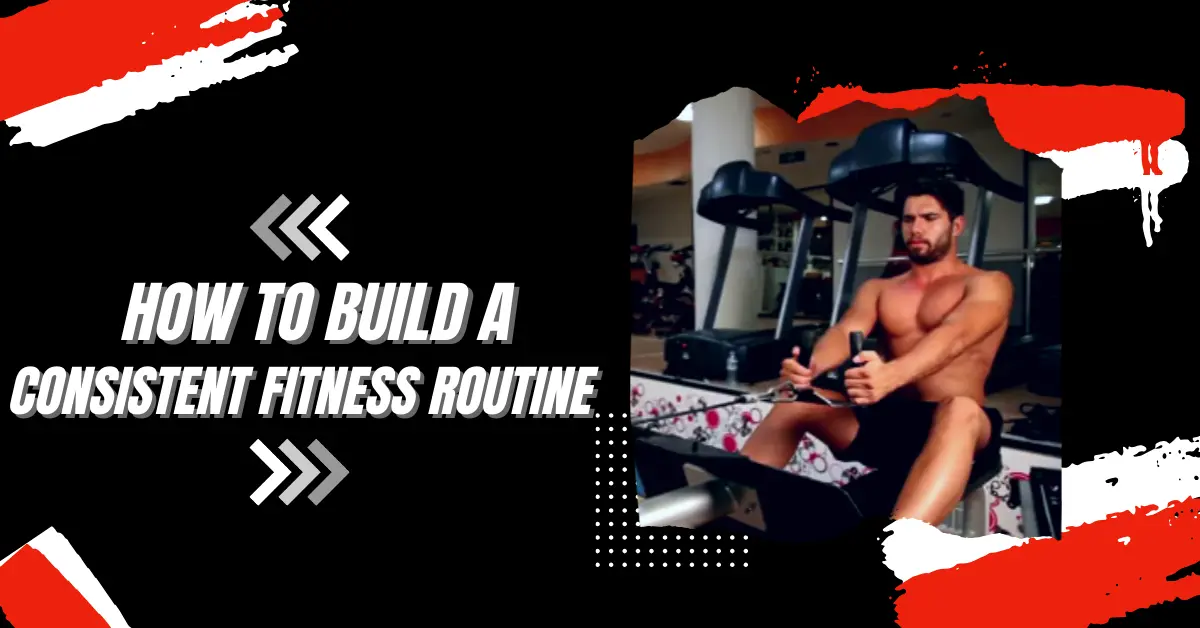
A consistent fitness routine is important because it helps keep your body healthy and strong. Regular exercise increases your energy, enhances your mood, and helps lower stress. It also helps maintain a healthy weight and supports better sleep. When you stick to a routine, your body gets used to the activity, making it easier to achieve your fitness goals. Plus, a regular schedule makes it easier to form healthy habits, which can lead to a happier and more balanced life. Being active is essential for your overall health.
How to Build a Consistent Fitness Routine
Getting fit and staying fit isn’t just about working out once in a while. It’s about creating a routine you can stick to over time. In this blog post, we’ll show you how to build a fitness routine that becomes a natural part of your life. We’ll cover everything about how to build a consistent fitness routine and from setting goals to staying motivated, so you can make fitness a lasting habit.
Why Consistency Matters in Fitness

Before we jump into the how to build a consistent fitness routine, let’s talk about why having a consistent fitness routine is so important:
- Better results: When you exercise regularly, your body gets stronger and fitter over time.
- Habit formation: The more you do something, the more automatic it becomes.
- Mental health benefits: Regular exercise can help reduce stress and improve mood.
- Time management: A routine helps you plan your day better.
- Long-term health: Consistent exercise has lasting benefits for your overall health.
Setting Clear Fitness Goals
The first step in building a consistent fitness routine is knowing what you want to achieve. Here’s how to set clear, achievable goals:
- Be specific: Instead of “get in shape,” try “run a 5K” or “do 10 push-ups in a row.”
- Make them measurable: Choose goals you can track with numbers.
- Set a timeline: Give yourself a deadline, but be realistic.
- Write them down: Write down your goals and place them in a visible spot where you can see them daily.
- Start small: It’s okay to have big dreams, but start with smaller, achievable goals.
Remember, your goals might change as you progress, and that’s okay!
Creating Your Fitness Plan

Now that you have your goals, it’s time to create a plan. Here’s how to create a fitness routine you can stick to:
- Choose activities you enjoy: You’re more likely to keep doing the exercise you like. This could be walking, swimming, dancing, or anything that gets you moving.
- Set a schedule: Decide which days and times you’ll exercise. Try to pick times that work well with your daily routine.
- Start slow: If you’re new to exercise, start with just 2-3 days a week. You can slowly increase this over time.
- Mix it up: Include different types of exercise in your routine:
- Cardio: Activities that get your heart rate up, like walking, jogging, or cycling.
- Strength training: Exercises that build muscle, like push-ups, squats, or lifting weights.
- Flexibility: Stretching or yoga to keep your muscles and joints healthy.
- Plan for rest: Your body needs time to recover. Include at least one or two rest days each week.
- Be realistic: Choose a routine you can stick to. It’s better to do less consistently than to burn out trying to do too much.
Making Time for Fitness
One of the biggest challenges in building a consistent fitness routine is finding time. Here are some tips to help:
- Schedule your workouts: Put them in your calendar like any other important appointment.
- Wake up earlier: Even 30 minutes can be enough time for a quick workout.
- Use your lunch break: A brisk walk or quick strength training session can fit into a lunch hour.
- Break it up: If you can’t find a big chunk of time, try doing shorter 10-15 minute sessions throughout the day.
- Make it a family activity: Exercise with your kids or partner to spend time together while getting fit.
- Cut back on screen time: Use the time you might spend watching TV or scrolling on your phone for exercise instead.
Remember, consistency is more important than length. Even short, regular workouts are better than occasional long ones.
Setting Up Your Environment for Success

Your surroundings can have a big impact on your ability to stick to a fitness routine. Here’s how to set up your environment for success:
- Keep your gear ready: Have your workout clothes and equipment easily accessible.
- Create a workout space: Even if it’s just a corner of your room, having a designated area for exercise can help.
- Use visual reminders: Put your running shoes by the door or your yoga mat in plain sight.
- Remove obstacles: If getting to the gym is a challenge, find ways to exercise at home or outdoors nearby.
- Plan for bad weather: Have indoor alternatives for days when you can’t exercise outside.
- Use technology: Set reminders on your phone or use fitness apps to track your progress.
Staying Motivated
Even with the best plans, staying motivated can be tough. Here are a few tips to help you stay motivated:
- Monitor your progress: Maintain a workout journal or use a fitness app to track your achievements.
- Celebrate small wins: Did you work out three times this week? That’s worth celebrating!
- Find a workout buddy: Having someone to exercise with can make it more fun and keep you accountable.
- Join a class or group: Being part of a fitness community can provide support and motivation.
- Reward yourself: Set milestones and give yourself non-food rewards when you reach them.
- Focus on how you feel: Notice how exercise improves your mood, energy, and overall well-being.
- Stay adaptable: If you miss a workout, don’t lose hope. Simply return to your routine the following day.
Overcoming Common Obstacles
You might face some challenges as you try to build your fitness routine. Here’s how to handle them:
- Lack of energy: Remember that exercise often gives you more energy. Begin with a simple, short workout and notice how you feel.
- Boredom: Try new activities or workout videos. Join a class or sports team for variety.
- Plateaus: If you stop seeing progress, it might be time to change up your routine.
- Injuries: Talk to your doctor about safe ways to exercise. There are usually modifications you can make.
- Travel or schedule changes: Have a backup plan for busy days, like quick hotel room workouts or early morning walks.
- Loss of motivation: Remind yourself why you started. Reflect on your goals and the progress you’ve made.
Nutrition and Hydration

A consistent fitness routine isn’t just about exercise. What you eat and drink plays a big role too:
- Stay hydrated: Stay hydrated by drinking water before, during, and after your workouts.
- Eat balanced meals: Include a mix of proteins, carbohydrates, and healthy fats in your diet.
- Time your meals: Try to eat a light meal or snack about 1-2 hours before exercising.
- Refuel after workouts: Have a snack with protein and carbs within an hour after exercising.
- Plan your meals: Having healthy food ready makes it easier to stick to your fitness goals.
- Don’t overcompensate: Be careful not to eat much more just because you’re exercising.
Remember, good nutrition supports your fitness efforts and helps you recover better.
Listening to Your Body

As you build your fitness routine, it’s important to pay attention to how your body feels:
- Begin at a slow pace: Slowly raise the intensity and length of your workouts over time.
- Rest when needed: If you’re feeling very tired or sore, it’s okay to take an extra rest day.
- Know the difference between good and bad pain: Some muscle soreness is normal, but sharp or persistent pain isn’t.
- Adjust your routine: If something doesn’t feel right, modify the exercise or try something different.
- Get enough sleep: Good sleep is crucial for recovery and maintaining your routine.
- Manage stress: High-stress levels can impact your energy and motivation. Include stress-reducing activities in your routine.
Tracking Your Progress

Seeing your progress can be a great motivator. Here are several methods to monitor your fitness journey:
- Take measurements: Record your weight, body measurements, or body fat percentage regularly.
- Do fitness tests: Try periodic tests like seeing how many push-ups you can do or how fast you can run a mile.
- Keep a workout log: Write down what exercises you do, for how long, and how they feel.
- Take progress photos: Visual changes can be motivating to see over time.
- Notice daily life improvements: Are everyday tasks getting easier? Do you have more energy?
- Use fitness apps or devices: These can help you track workouts, steps, heart rate, and more.
Remember, progress isn’t always linear. Some weeks you might see big improvements, while others might feel like you’re standing still. That’s normal!
Conclusion
Building a consistent fitness routine takes time and effort, but it’s worth it. Remember these key points:
- Set clear, achievable goals
- Create a plan that fits your life
- Make time for fitness
- Set up your environment for success
- Stay motivated and celebrate your progress
- Overcome obstacles as they come up
- Pay attention to nutrition and hydration
- Listen to your body
- Track your progress
Most importantly, be patient with yourself. Building a new habit takes time. If you slip up, don’t get discouraged. Just get back on track with your next scheduled workout.
Remember, the best fitness routine is one that you can stick to long-term. It should fit into your life and be something you enjoy. As you continue on your fitness journey, you’ll likely find that it becomes less of a chore and more of a natural, enjoyable part of your day.
FAQs
1. What should I include in my fitness routine?
Incorporate a combination of cardio, strength training, and flexibility workouts. This balance helps improve overall fitness and keeps your workouts interesting.
2. How often should I work out?
Try to get a minimum of 150 minutes of moderate exercise every week. This can be spread over several days, making it easier to fit into your schedule.
3. What if I miss a workout?
Don’t worry. Simply resume your routine the following day. Consistency is key, and missing one workout won’t derail your progress.
4. How can I stay motivated?
Set small, achievable goals and track your progress. Working out with friends or joining a class can also make exercising more fun and motivating.
5. How long will it take to see results?
Results vary by person, but you may start to feel better within a few weeks. Visible changes can take a few months, so be patient and stay consistent.
Also Read:
Beginner’s Guide to Starting a Fitness Journey
5 Tips to Keep Kids Active and Healthy
References:
https://pubmed.ncbi.nlm.nih.gov/31267674/
https://pubmed.ncbi.nlm.nih.gov/32658039/
https://en.wikipedia.org/wiki/Fitness
Disclaimer: The information provided in this blog on building a consistent fitness routine is for educational purposes only. It should not replace professional fitness advice. Please consult a fitness expert or healthcare provider before starting any new exercise program.
Related post

7 Health Benefits of Assam Tea


